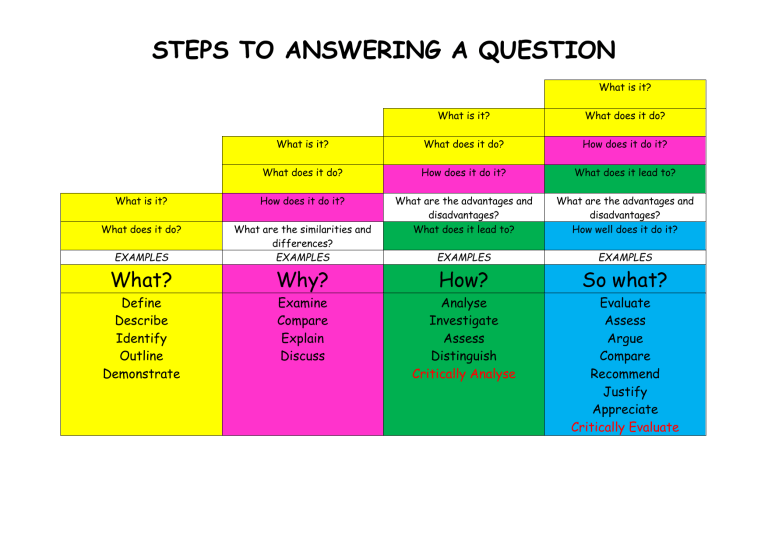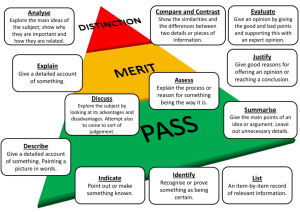
STEPS TO ANSWERING A QUESTION What is it? What is it? What does it do? What is it? What does it do? How does it do it? What does it do? How does it do it? What does it lead to? What is it? How does it do it? What does it do? What are the advantages and disadvantages? How well does it do it? EXAMPLES What are the similarities and differences? EXAMPLES What are the advantages and disadvantages? What does it lead to? EXAMPLES EXAMPLES What? Why? How? So what? Define Describe Identify Outline Demonstrate Examine Compare Explain Discuss Analyse Investigate Assess Distinguish Critically Analyse Evaluate Assess Argue Compare Recommend Justify Appreciate Critically Evaluate STEPS TO ANSWERING A QUESTION What is it? What is it? What is it? What does it do? What is it? What does it do? What is it? What does it do? What are the features or characteristics? What is it? What does it do? What are the features or characteristics? What is the significance, purpose or function? What does it do? What are the features or characteristics? What is the significance, purpose or function? Explain how and why parts relate to each other. What are the features or characteristics? What is the significance, purpose or function? Explain how and why parts relate to each other. What are the positive and negatives? What are the advantages and disadvantages? What is it? What is it? What is it? What does it do? What does it do? What are the features or characteristics? Explain how and why parts relate to each other. What are the positive and negatives? What are the advantages and disadvantages? Make a judgement to what extent each part is successful, effective, suitable, useful, and appropriate. Explain how and why parts relate to each other. What are the positive and negatives? What are the advantages and disadvantages? Make a judgement to what extent each part is successful, effective, suitable, useful, and appropriate. Make a judgement to what extent overall is it successful, effective, suitable, useful, and appropriate. Explain how and why parts relate to each other. What are the positive and negatives? What are the advantages and disadvantages? Make a judgement to what extent each part is successful, effective, suitable, useful, and appropriate. Make a judgement to what extent overall is it successful, effective, suitable, useful, and appropriate. What is the big idea? What is the big picture? What did you learn? Make a judgement to what extent each part is successful, effective, suitable, useful, and appropriate. Make a judgement to what extent overall is it successful, effective, suitable, useful, and appropriate. What is the big idea? What is the big picture? What did you learn? How does learning link to life? What is the significance, purpose or function? What is the significance, purpose or function? What is the significance, purpose or function? What does it do? What are the features or characteristics? What are the features or characteristics? What does it do? What are the features or characteristics? What is the significance, purpose or function? Explain how and why parts relate to each other. What are the positive and negatives? What are the advantages and disadvantages? EXAMPLES EXAMPLES EXAMPLES EXAMPLES EXAMPLES EXAMPLES EXAMPLES EXAMPLES EXAMPLES How Well? How Well? Intrinsic and Extrinsic links. Links to life. Evaluate Critically Evaluate Conceptualise the topic Appreciate What? What? Why? How? How Well? Name and Define Describe Explain Analyse Critically Analyse Content: Can be taught by rote. Concept: Opinion, what you think.

